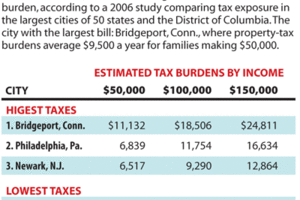Burdened by taxes? Try a new location.
Wallet Wise: Few think about taxes when choosing where to live, but it's worth learning how city and state tax codes differ.

Scott Wallace
Cherry blossoms in the nation's capital; opening day of the Boston Red Sox season; sails billowing on Chicago's Lake Michigan. Such rites of spring are sure to evoke a smile in mid-April.
Equally symbolic, if generally less welcome: tax time. With the ink not yet dry on many checks to state and local governments, Americans are focusing more on their tax burdens than on their local climate and attractions.
Yet many may never have considered taxes when deciding where to live. For most working families, employment opportunities, reputation of public schools, and proximity to family are the dominant factors when choosing to move. But once they have committed to a job, seeking a community to call home offers an opportunity to "tax shop" for a less expensive jurisdiction. Even within a county, taxes can vary as a result of special city levies.
For relocating retirees, however, the tax profile of a community emerges as a primary consideration. Smart retirees seek communities with the lowest income, property, and sales taxes – levies that can add up to significant expenses on a retirement budget.
The amount of variation is striking. Families earning the same income experience significant differences in the tax burdens they shoulder, depending on where they live (see chart). Salt Lake City, for example remains a bargain at all income levels with a flat tax structure neutralizing income increases. Washington, D.C., has a highly progressive tax structure that captures increments of income growth, serving as a disincentive for the relocation of higher income families.
Such tax differences reflect service demands of each city, the cost of providing those services, the profile of the tax base, and the opportunity to generate other sources of revenue. For example, Washington is prohibited by Congress from taxing the income of nonresidents, as many other cities do. Washington relies on income rather than property taxes to generate revenue, as 41 percent of its land value is tax-exempt, as government property.
(To compare the tax burden of major US cities, check http://brc.dc.gov/resources/facts.asp.)
A nationwide look at tax burdens reveals other disparities. Seven states – Alaska, Florida, Nevada, South Dakota, Texas, Washington, and Wyoming – have no income tax. Two states, New Hampshire and Tennessee, have no income tax, but do tax dividends and interest income.
While states without income taxes are appealing, it's worth eyeing other factors. Texas, for instance, has the nation's highest property tax as a percentage of home value. Nevada and Florida have higher-than-average sales taxes to capture tourist revenue. Alaska claims the lowest individual tax burden, with oil and energy revenues easing taxes for residents.
Taxes have also become a marketing focus, as states compete to attract residents. The District of Columbia's 12.5 percent tax burden, as a percentage of income, is not competitive with its closest neighbors, Virginia's 10.2 percent and Maryland's 10.8 percent. The bordering states of Arizona, California, and Nevada also create tax opportunities for residents who may choose to work in California, but reside in the lower tax states of Arizona or Nevada. Check out your state's competitive position at the website of the Tax Foundation (www.taxfoundation.org/taxdata/), a Washington-based nonprofit group.
• Kathleen Connell, PhD, is a professor at Haas Business School at the University of California, Berkeley.
